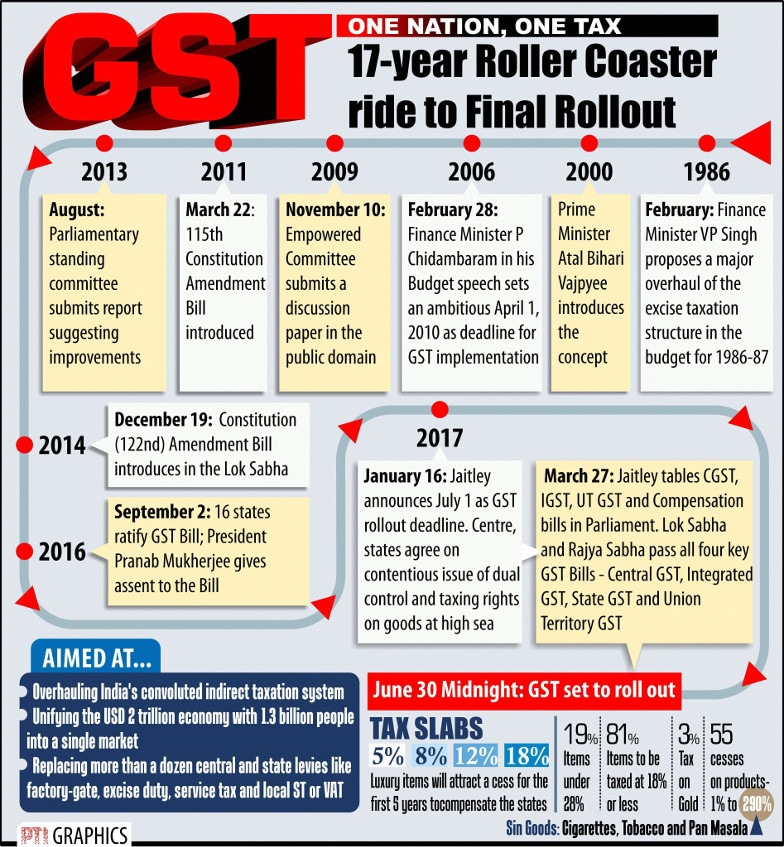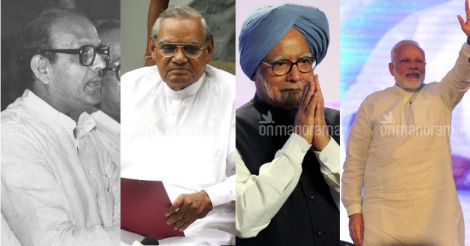New Delhi: After 17 tumultuous years, a nationwide Goods and Services Tax (GST) will roll out from Friday midnight, overhauling India's convoluted indirect taxation system and unifying the $2 trillion economy with 1.3 billion people into a single market.
GST, which replaces more than a dozen central and state levies like factory-gate, excise duty, service tax and local sales tax or VAT, is India's biggest tax reform in the 70 years of independence and will help modernize Asia's third largest economy.
Here is a look at the events that shaped 'one nation, one tax' system:
» February 1986: Finance minister Vishwanath Pratap Singh proposes a major overhaul of the excise taxation structure in the budget for 1986-87.
» 2000: Prime minister Atal Bihari Vajpyee introduces the concept, sets up a committee headed by the then West Bengal finance minister Asim Dasgupta to design a GST model.
» 2003: The Vajpayee government forms a task force under Vijay Kelkar to recommend tax reforms.
» 2004: Vijay Kelkar, then adviser to the Finance Ministry, recommends GST to replace the existing tax regime.
» February 28, 2006: GST appears in the Budget speech for the first time; finance minister P Chidambaram sets an ambitious April 1, 2010 as deadline for GST implementation. He says the Empowered Committee of finance ministers will prepare a road map for GST.
» 2008: Empowered Committee of State Finance Ministers constituted.
» April 30, 2008: The Empowered Committee submits a report titled 'A Model and Roadmap Goods and Services Tax (GST) in India' to the government
Read: GST on the doorsteps: 5 challenges ahead for small and medium enterprises
» November 10, 2009: The empowered committee submits a discussion paper in the public domain on GST welcoming debate.
» 2009: Finance minister Pranab Mukherjee announces basic structure of GST as designed by Dasgupta committee; retains 2010 deadline.
» BJP opposes GST basic structure.

» February 2010: Finance Ministry starts mission-mode computerization of commercial taxes in states, to lay the foundation for GST rollout.
» Pranab Mukherjee defers GST to April 1, 2011.
» March 22, 2011: UPA-II tables 115th Constitution Amendment Bill in the Lok Sabha for bringing GST.
» March 29, 2011: GST Bill referred to Parliamentary Standing Committee on Finance led by Yashwant Sinha.
» Asim Dasgupta resigns, replaced by the then Kerala finance minister KM Mani.
Read: GST could snuff out parallel economy
» November 2012: Finance minister P. Chidambaram holds meetings with state finance ministers; decides to resolve all issues by December 31, 2012 for GST rollout.
» February 2013: Declaring UPA government's resolve to introducing GST, Chidambaram in his Budget speech makes provision for Rs 9,000 crore to compensate states for losses incurred because of GST.
» August 2013: Parliamentary standing committee submits report to Parliament suggesting improvements on GST. GST Bill gets ready for introduction in Parliament.
» October 2013: Gujarat chief minister Narendra Modi opposes GST Bill saying state would incur losses worth Rs 14,000 crore every year due to GST.
» 2014: GST Bill cleared by Standing Committee lapses as Lok Sabha dissolves; BJP-led NDA government comes to power.
» December 18, 2014: Cabinet approves 122nd Constitution Amendment Bill to GST.
» December 19, 2014: Finance minister Arun Jaitley introduces the Constitution (122nd) Amendment Bill in the Lok Sabha; Congress objects.
» February 2015: Jaitley sets April 1, 2016 as deadline for GST rollout.
» May 6, 2015: Lok Sabha passes GST Constitutional Amendment Bill.
» May 12, 2015: The Amendment Bill presented in the Rajya Sabha.
» Congress demands the Bill be sent to Select Committee of Rajya Sabha; demands capping GST rate at 18 percent.
» May 14, 2015: The GST Bill forwarded to joint committee of Rajya Sabha and Lok Sabha.
» August 2015: Government fails to win the support of Opposition to pass the bill in the Rajya Sabha where it lacks sufficient number.
Read: 72 percent of traders in Kerala are GST-ready
» July 2016: Center opposes capping GST rate at 18%; gets states around.
» August 2016: Congress, BJP agree to pass the Constitution Amendment Bill.
» August 3, 2016: Rajya Sabha passes the Constitution Amendment Bill by two-thirds majority.
» September 2, 2016: 16 states ratify GST Bill; President Pranab Mukherjee gives assent to the Bill.
» September 12: Union Cabinet clears formation of GST Council
» September 22-23: Council meets for first time.
» November 3: GST Council agrees on four slab tax structure of 5, 12, 18 and 28% along with an additional cess on luxury and sin goods.
» January 16, 2017: Jaitley announces July 1 as GST rollout deadline. Center, states agree on contentious issue of dual control and taxing rights on goods at high sea.
» February 18: GST Council finalizes draft compensation bill providing to make good any revenue loss to states in first five years of GST rollout.
» March 4: GST Council approves CGST and Integrated-GST bills.
» March 20: Cabinet approved CGST, IGST and UT GST and Compensation bills.
» March 27: Jaitley tables CGST, IGST, UT GST and Compensation bills in Parliament. Lok Sabha and Rajya Sabha pass all the four key GST Bills - Central GST (CGST), Integrated GST (IGST), State GST (SGST) and Union Territory GST (UTGST).
» May 18: GST Council fits over 1,200 goods in one of the four tax slabs of 5, 12, 18 and 28%. Over 80% of goods of mass consumption either exempted or taxed under 5% slab.
» GST Council fixes cess on luxury and sin goods to create kitty for compensating states.
» May 19: GST Council decides on 5, 12, 18 and 28% as service tax slabs.
» June 21: All states except Jammu and Kashmir pass SGST law.
» June 28: Mamata Banerjee announces her party's decision to skip midnight launch of GST.
» June 29: Congress, Left too decide to skip launch.
» June 30 Midnight: GST set to roll out.
Read: Latest updates on GST | Markets end in green, brace for initial GST hiccups

























 (From left) VP Singh, AB Vajpayee, Manmohan Singh and Narendra Modi. India's historic GST was formed during the tenures these prime ministers
(From left) VP Singh, AB Vajpayee, Manmohan Singh and Narendra Modi. India's historic GST was formed during the tenures these prime ministers


